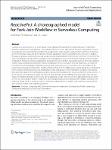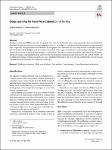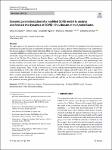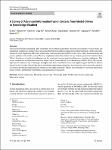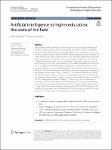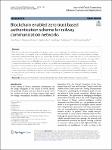Search
Author
- Jorgensen, Ed (3)
- McFadyen, Ron (3)
- Nora, El-Rashidy (3)
- Christian, Homeyer (2)
- next >
Subject
- programming (10)
- Open Access (8)
- Java (7)
- Programming (7)
- next >
Date issued
- 2020 - 2025 (293)
- 2010 - 2019 (39)
- 2000 - 2009 (2)
- 1999 - 1999 (1)
Has File(s)
- true (335)
Search Results
Function-as-a-Service (FaaS) is an event-based reactive programming model where functions run in ephemeral stateless containers for short duration. For building complex serverless applications, function composition is crucial to coordinate and synchronize the workflow of an application. Some serverless orchestration systems exist, but they are in their primitive state and do not provide inherent support for non-trivial workflows like, Fork-Join. To address this gap, we propose a fully serverless and scalable design model ReactiveFnJ for Fork-Join workflow. The intent of this work is to illustrate a design which is completely choreographed, reactive, asynchronous, and represents a dynamic composition model for serverless applications based on Fork-Join workflow. |
The correct and robust recognition of traffic signs is indispensable to self-driving vehicles and driver-assistant systems. In this work, we propose and evaluate two network architectures for multi-expert decision systems that we test on a challenging Traffic Sign Recognition Benchmark dataset. The decision systems implement individual experts in the form of deep convolutional neural networks (CNNs). A gating network CNN acts as final decision unit and learns which individual expert CNNs are likely to contribute to an overall meaningful classification of a traffic sign. The gating network then selects the outputs of those individual expert CNNs to be fused to form the final decision. |
Historical documents are an important part of our cultural heritage. Among other task related to their processing, it is important to modernize their language in order to make them accessible to a broader audience and to achieve an orthography consistency to reduce the linguistic variation inherent in them. Language modernization and spelling normalization have those goals in mind. However, they still have a long way to go. Thus, in order to help scholars generate error-free modernizations/normalizations when the quality is essential, we propose an interactive framework based on interactive machine translation. In this work, we deployed two different interactive protocols into these tasks. We evaluated our proposal under simulated environments, observing significant reductions of th... |
Head pose estimation (HPE) is an active and popular area of research. Over the years, many approaches have constantly been developed, leading to a progressive improvement in accuracy; nevertheless, head pose estimation remains an open research topic, especially in unconstrained environments. In this paper, we will review the increasing amount of available datasets and the modern methodologies used to estimate orientation, with a special attention to deep learning techniques. We will discuss the evolution of the field by proposing a classification of head pose estimation methods, explaining their advantages and disadvantages, and highlighting the different ways deep learning techniques have been used in the context of HPE. An in-depth performance comparison and discussion is presente... |
The rapid spread of the numerous outbreaks of the coronavirus disease 2019 (COVID-19) pandemic has fueled interest in mathematical models designed to understand and predict infectious disease spread, with the ultimate goal of contributing to the decision making of public health authorities. Here, we propose a computational pipeline that dynamically parameterizes a modified SEIRD (susceptible-exposed-infected-recovered-deceased) model using standard daily series of COVID-19 cases and deaths, along with isolated estimates of population-level seroprevalence. |
Model transformations are central to model-driven software development. Applications of model transformations include creating models, handling model co-evolution, model merging, and understanding model evolution. In the past, various (semi-)automatic approaches to derive model transformations from meta-models or from examples have been proposed. These approaches require time-consuming handcrafting or the recording of concrete examples, or they are unable to derive complex transformations. We propose a novel unsupervised approach, called OCKHAM, which is able to learn edit operations from model histories in model repositories. OCKHAM is based on the idea that meaningful domain-specific edit operations are the ones that compress the model differences. |
The main objective of this research is to determine the perception of teachers about the elements that increases the educational effectiveness of gamified apps in primary education. A methodology based on an importance-performance analysis was daeveloped, using a structural equations model to calcuate the degree of importance of each variable. The sample was formed of 212 Spanish teachers with experience using educational apps in the teaching–learning process. Six categories were identified as precursors of educational effectiveness: (1) curriculum connection, (2) feedback and operational experience, (3) assessment and learning analytics, (4) sustainability (Protection Personal data), (5) equal access and (6) flow. These six categories enhance the three traditional areas of gamifica... |
Advanced knowledge engineering (KE), represented by knowledge graph (KG), drives the development of various fields and engineering technologies and provides various knowledge fusion and knowledge empowerment interfaces. At the same time, advanced system engineering (SE) takes model-based system engineering (MBSE) as the core to realize formal modeling and process analysis of the whole system. The two complement each other and are the key technologies for the transition from 2.0 to 3.0 in the era of artificial intelligence and the transition from perceptual intelligence to cognitive intelligence. This survey summarizes an advanced information fusion system, from model-driven to knowledge-enabled. Firstly, the concept, representative methods, key technologies and application fields of... |
This systematic review provides unique findings with an up-to-date examination of artificial intelligence (AI) in higher education (HE) from 2016 to 2022. Using PRISMA principles and protocol, 138 articles were identified for a full examination. Using a priori, and grounded coding, the data from the 138 articles were extracted, analyzed, and coded. The findings of this study show that in 2021 and 2022, publications rose nearly two to three times the number of previous years. With this rapid rise in the number of AIEd HE publications, new trends have emerged. The findings show that research was conducted in six of the seven continents of the world. |
With the introduction of emerging technologies such as cloud computing, the railway communication network has the characteristics of complex structure and blurred boundaries, which leads to a series of security threats including information leakage and malicious access. Specifically, the third-party cloud services are difficult to be supervised, and network traffic is untrustworthy. To ensure system security, we propose a zero-trust security model in this paper. Then, we introduce blockchain and Merkle tree to build a distributed identity storage scheme for guaranteeing reliable, confidential and efficient data updates, and improving authentication efficiency. |

